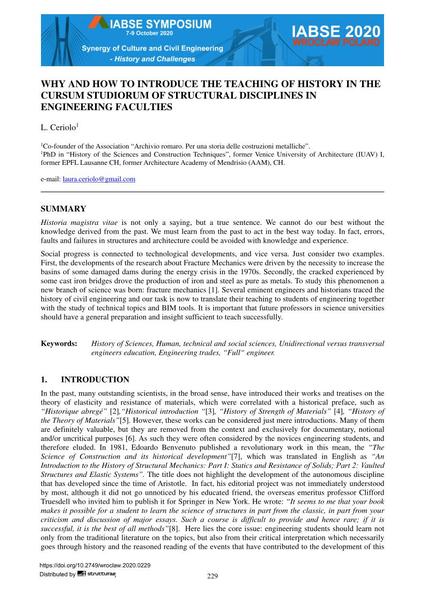Why and How to Introduce the Teaching of History in the Cursum Studiorum of Structural Disciplines in Engineering Faculties

|
|
|||||||||||
Bibliografische Angaben
| Autor(en): |
L. Ceriolo
|
||||
|---|---|---|---|---|---|
| Medium: | Tagungsbeitrag | ||||
| Sprache(n): | Englisch | ||||
| Tagung: | IABSE Symposium: Synergy of Culture and Civil Engineering – History and Challenges, Wrocław, Poland, 7-9 October 2020 | ||||
| Veröffentlicht in: | IABSE Symposium Wroclaw 2020 | ||||
|
|||||
| Seite(n): | 229-236 | ||||
| Anzahl der Seiten (im PDF): | 8 | ||||
| Jahr: | 2020 | ||||
| DOI: | 10.2749/wroclaw.2020.0229 | ||||
| Abstrakt: |
Historia magistra vitae is not only a saying, but a true sentence. We cannot do our best without the knowledge derived from the past. We must learn from the past to act in the best way today. In fact, errors, faults and failures in structures and architecture could be avoided with knowledge and experience. Social progress is connected to technological developments, and vice versa. Just consider two examples. First, the developments of the research about Fracture Mechanics were driven by the necessity to increase the basins of some damaged dams during the energy crisis in the 1970s. Secondly, the cracked experienced by some cast iron bridges drove the production of iron and steel as pure as metals. To study this phenomenon a new branch of science was born: fracture mechanics [1]. Several eminent engineers and historians traced the history of civil engineering and our task is now to translate their teaching to students of engineering together with the study of technical topics and BIM tools. It is important that future professors in science universities should have a general preparation and insight sufficient to teach successfully. |
||||
